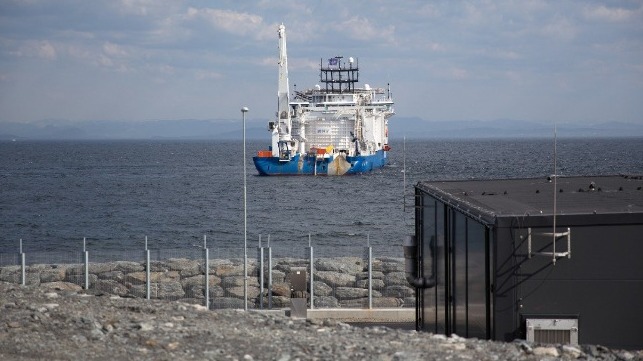The laying of the cable supplying the Johan Sverdrup offshore development in Norway with power from shore started last week. The cable, being deployed by NKT Victoria, will help make the North Sea giant one of the oil and gas fields with the lowest CO2 emissions worldwide.
The starting point was the Johan Sverdrup converter station at Haugsneset near Kårstø, and by the end of May the vessel is expected to have laid nearly 200 kilometers of power cables out to the field. This will be a rate of about 10 kilometers (six miles) of cable a day.
Bundled with the power cables will be a fiber-optic cable for communication which will enable monitoring and, when required, remote control of parts of the Johan Sverdrup field’s operations from shore.
The power cables will help make Johan Sverdrup one of the most carbon-efficient oil and gas fields in the world. Estimated at just 0.5 kg of CO2 per barrel, the emissions from Johan Sverdrup are about 20 times lower than the average on the Norwegian continental shelf, and 30 times lower than the international average.
This makes Johan Sverdrup a key project to help deliver on Statoil’s ambition of reducing annual carbon emissions by three million tons by 2030, compared with the estimated emissions. The CO2 emissions avoided as a result of Johan Sverdrup using power from shore add up to more than 400,000 tons of C02 per year, equivalent to the emissions of some 200,000 cars each year.
Several additional measures have been implemented to further reduce emissions during the Johan Sverdrup development: the cable-laying vessel NKT Victoria was designed to be supplied with power from shore while in harbor. The mobile accommodation vessel Haven, in use at the field from June onwards, has also been modified to use power from shore while in service at the Johan Sverdrup field. Based on current plans, the Johan Sverdrup field will be powered from shore this autumn, so that all the field’s power needs during the remaining hook-up and finalization phase will be met with electricity supplied from shore.
Sverdrup is one of the five largest oil fields on the Norwegian continental shelf. With expected resources of between 1.9 and 3.0 billion barrels of oil equivalents, it will also be one of the most important industrial projects in Norway over the next 50 years.
Plateau production is estimated to account for 40 percent of Norwegian Continental Shelf oil production, and the project will have an expected recovery rate of 70 percent and a field life of 50 years. Peak production will constitute 25 percent of all Norwegian petroleum production at the time.
The field is located on the Utsira Height in the North Sea, 160 kilometers west of Stavanger. Oil from the field will be piped to the Mongstad terminal in Hordaland. Gas will be transported via Statpipe to the Kårstø processing plant in North Rogaland. Water depth is around 120 meters (390 feet), with the reservoir is located at a depth of 1,900 meters (6,200 feet).
After the start-up of the second phase of the development in 2022, the Johan Sverdrup field will also enable power from shore to reach the remaining fields on the Utsira High – Edvard Grieg, Gina Krog and Ivar Aasen.

 17.04.2024 18:00
17.04.2024 18:00
 17.04.2024 11:30
17.04.2024 11:30
 16.04.2024 11:45
16.04.2024 11:45